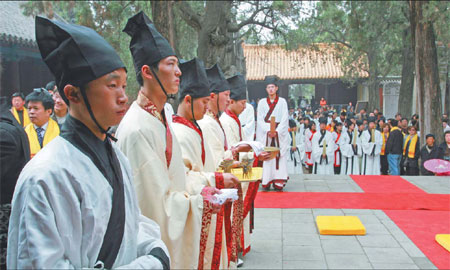Moving mountains
Updated: 2013-04-19 09:37
(China Daily)
|
|||||||||||
|
Students from China and South Korea pay homage to Confucius at Nishan Hill. Provided to China Daily |
|
A portrait of Confucius on the wall of the lecture hall that is used for venerating the philosopher on Nishan Hill. Jixiang / China Daily |
Qufu is famed for its association with Confucius but most visitors overlook three peaks nearby that hold natural beauty, legends and strong ties to philosopher
For visitors to Qufu, the hometown of Confucius, a trip to the Three Kongs, the temple, the mansion and cemetery associated with the great philosopher, is almost obligatory.
But what most travelers overlook are three equally impressive mountains and hills that surround the city and offer respite from the tourist hordes.

The three mountains and hills of Qufu are worth a visit for their natural beauty alone, but they also hold historical and cultural treasures that make the climb a must.
1. Nishan Hill
While Qufu is famed as the city of Confucius, it was in fact on Nishan Hill that the man whose ideas have shaped China is said to have been born, in a three-meter deep cave called Kunling at the foot of the hill.
According to legend the baby Confucius was abandoned shortly after birth because his mother thought he was ugly, but was rescued by a tiger and an eagle, which later made the mother take him back.
Higher than Kunling Cave and to the west is River Watching Pavilion, from where Confucius is supposed to have watched the river flowing and gasped at how rapidly earthly life changes.
The hill is also home to a Confucian temple that houses an old lecture hall used today solely for venerating the philosopher.
Behind the lecture hall is an earthen hall, which in ancient China was a common construction used for honoring the God of the Earth. Here, Confucius is said the have received help from the God of the Earth on his way to becoming a saint.
The educational center Nishan Academy on the hill was a site of scholarly discussion for centuries and still serves a similar purpose with school visits on occasions.
2. Nine Fairy Mountain
Like many picturesque mountains across China, Nine Fairy Mountain is associated with legend.
The story goes that the nine fairy maidens of the Queen Mother of the West escaped to the mountain while the Queen Mother was happily drunk during her birthday party. Angry at their departure, the Queen Mother then transformed the fairy maidens into nine peaks.
Today the mountain is dotted with brooks, fruit trees and agricultural land, and is a source of many medicinal herbs, no doubt having grown with the help of the nine fairies.
In ancient China, the mountain was home to many religious groups that have left their mark in the form of temples, including Confucianists, Daoists and Buddhists.
During the Qing Dynasty (1644-1911) an annual temple fair was started on the mountain in spring, drawing hundreds of peddlers, incense burners and performers. The temple fair later came to a halt during times of social unrest, but was restored by the local government in the 1990s along with several historical sites.
At the highest reaches of the mountain is the Bixia Ancestral Temple. Bixia was, according to legend, a fairy who did many kind deeds and whom local people called "grandma". A statue of Bixia stands in the temple's main hall.
Behind the temple are three stones said to emanate coolness even during the hottest summer day, making this a pleasant place to take a break.
On the northeastern section of the mountain is Phoenix Hill. With an elevation of 548 meters it is the tallest peak in Qufu.
Across the mountain it is not uncommon to see fruit laid out in the sun, including pears, dates, peaches and pomegranates. Even at harvest time in late autumn people often do this to satisfy a local liking for dried fruit.
3. Stone Gate Mountain
Stone Gate Mountain has 14 peaks, two of which sit opposite each other, creating the gate shape that gives the mountain its name. The mountain is divided into three main areas: Stone Gate Temple, Peach Dock and Yellow Mountain.
Of the 14 peaks, Shenghan Peak is the tallest at 406 meters. It is also well known for its caves and links with ancient philosophers and poets.
Confucius and his students frequented the mountain and used it as a place to study. The poets Li Bai and Du Fu also toured the mountain together.
More than 90 of the mountain is covered with forest, making its' 6 square kilometers a natural oxygen bar.
China Daily
(China Daily 04/19/2013 page23)
Today's Top News
Alibaba pays $586 million for stake in Sina Weibo
Three buried after lab explosion
EU to ban pesticides blamed for harming bees
City unites to say farewell
Small stores rely on new retail revolution
Taobao creates new job specifications
Beauties turn entrepreneurs
Flooding season nears in Ya'an
Hot Topics
Lunar probe , China growth forecasts, Emission rules get tougher, China seen through 'colored lens', International board,
Editor's Picks

|

|

|

|

|

|







